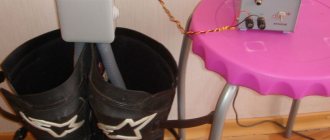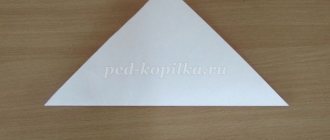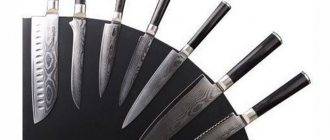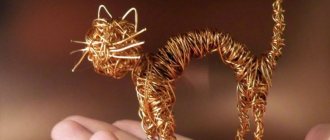To quickly strip electrical single- or multi-core wires, a special tool is usually used - a stripper. However, the author suggests making an alternative to it and saving money.
To make a simple device for removing insulation from wires with your own hands, you will need a small piece of polypropylene pipe about 15-20 cm long, as well as a segmented blade for a stationery knife.
First of all, the author applies a segment blade to a piece of PP pipe, after which, using a regular pencil, he places marks on the surface of the pipe at approximately the same distance from each other.
Main stages of work
Then the polypropylene pipe must be connected to another PP pipe, secured at the edges with electrical tape. In this case, the lines drawn in pencil should be visible as shown in the photo below.
At the next stage, using drills of various diameters, you need to make small transverse “grooves” on the polypropylene tube.
After this, the “grooves” made with the drill will need to be deepened so that a through hole is formed in the pipe wall. We clamp the workpiece in a vice, as if flattening it a little, and insert a segment blade inside.
The result was a homemade device for stripping wires. Cheap and cheerful, as they say. You can remove insulation from wires of different sections.
For details on how to make a simple device for removing insulation from wires, watch this video.
Safety blade
How to properly remove insulation without defects?
The protective coating of any stranded copper wire must be dual-functional: strong and at the same time elastic. In other words, do not allow moisture on the copper and subsequent oxidation of the wire and easily allow for partial necessary removal from the core. Our step-by-step instructions will help you on how to properly strip wires.
What kind of damage can be expected from unprofessional stripping of a wire end?
- reducing the cross-section of the conductor;
- fractures of part of the copper threads in the core and a drop in strength characteristics;
- hidden defects when using blunt stripping devices - from stretching and bending;
- loss of part of the copper threads in the multistrand;
- contamination with residual insulation of the conductor.
Briefly about the main thing
The use of special tools for cleaning conductors from the sheath allows not only to increase the speed and quality of work, but also to avoid a number of negative consequences:
- Core damage.
- Hidden defects.
- Reduced wiring strength.
- Breakage of individual veins.
- The conductor is clogged with insulation material.
Modern peeling tools are classified according to three criteria - removal method, speed and degree of automation. Elementary methods at home allow you to remove insulation by heating or using a knife. For large volumes of work, special devices are used - wire cutters and pliers, electrical knives, strippers, side cutters and pliers. When choosing a method and tool, among other parameters, it is necessary to take into account the type of shell material.
We clean it correctly
All of the above is the result of the activities of amateurs in electrical engineering. Professionals can only laugh at how a man tears the braid with his already fragile teeth or hardly pulls it off the end with rusty wire cutters. This can be seen in numerous Internet photos of wire stripping.
Below is a proven method of electrical engineers and craftsmen on how to strip a wire of insulation with your own hands quickly and efficiently. First, about simplicity for dummies.Experienced electricians know all the secrets of working with wires and use one or more tools to expose the wires. And not only multi-strand ones, but also single and thick ones - copper or aluminum, for indoor and outdoor wiring.
Types of instruments
Modern tools used for stripping wires and cables are classified according to several criteria:
- Method of removing the shell.
Two methods are used - thermal and mechanical. The first is typical for conductors with a small cross-section and a small amount of work, the second - for professional maintenance and a large number of operations.
Depending on the method of influencing the shell material, mechanical methods are divided into two types:
- Cutting. The cutting edge of the tool carefully cuts the sheath around the metal core, after which a smaller part of it is simply removed from the edge of the conductor.
- Break. Using special teeth, the conductor is clamped in the working part of the tool, and then the sheath is forcefully torn off along the conductor.
Special teeth on the tool allow you to quickly and easily remove insulation from wires Source proraboff.rf
The choice of method and type of tool is primarily determined by the cross-sectional area of the conductor, complexity and volume of work.
- Operation speed.
According to the parameter of the number of shell removal operations performed in a certain period of time, tools are divided into 2 categories:
- Household. These include electrical knives, side cutters, and pliers. The devices are designed for stripping wires with a small amount of work.
- Professional. These are primarily strippers, tongs, pliers and pullers. They make it possible to quickly strip the conductor sheath.
A knife is most often used in everyday life due to its availability, ease of use and low cost.
- Degree of automation.
According to the degree of automation, devices are divided into manual, semi-automatic and automatic. This classification is typical primarily for professional instruments.
An automatic stripper significantly increases the productivity of conductor stripping Source remitek.ru
On a note! Cleaning tools can be either universal or special purpose - for example, only for an Internet cable or power wire. They may also differ in the diameter of the conductor. The most popular models are for cores with a diameter of 4 to 40 mm.
See also: Catalog of companies that specialize in engineering systems (heating, water supply, sewerage and others) and related work
Using a regular knife
A well-sharpened blade is easily protected by a braid of polyvinyl chloride and rubber protection. The first is the most widely used sheath today for copper and other wires with a cross-section from half a millimeter to four. They pressed the blade onto the shell and pulled sharply. More often than not, a piece of wrapper comes off nicely and efficiently. But sometimes the braid does not yield to the knife.
This occurs at a cross section larger than 2.5 millimeters. Then use the same knife to ring the protective surface, being careful not to reach the copper threads of the wire. It is better to perform this procedure on a board, rolling the knife around the circumference. Another method is transverse dissection. Bend the wire and easily make a notch at the top of the bend. It will be easy to remove further.
Longitudinal notch. Run the tip of a sharp blade along the length of the intended braid removal. Try not to touch the copper wires. You bend it and cut it off. This method is suitable for braiding with two or three layers of different protection.
Copper Cable Cleaning Machines
In addition to hand tools, automated strippers are produced. They are easier to use and can significantly increase the speed of operations.
The device is mounted on the table using a clamp. Structurally, it is a pliers with 2 pairs of jaws and cams on the levers. The lower part is rigidly fixed, the upper part is movable.
When the lever is lowered, the left pair of jaws clamps the wire, the right pair cuts into the insulation with sharp edges. Subsequent movement of the handle leads to a horizontal displacement of the second part, as a result of which the shell is pulled off.
Thus, the machine allows you to strip the wire in one movement. The limiters completely eliminate damage to the metal, the cut is smooth and neat.
Forceps
There are many factory tools for removing braid. Assortment by price - from budget to exclusive. The usual one has two devices: the first one uses a gauge to remove the braid, and the other hole protects the copper wires.
Buy power cable VVGnglsElectrical wiring diagram in the garage - features of design and installation with your own hands. 120 photos of wiring examples and video instructions for replacing wiring in the garage
Which wire to use for grounding: calculation of parameters, marking and purpose of various types of wires (video instructions + 150 photos)
The pliers are well suited for working with used wire where the copper is slightly burnt. After cleaning the core, you can use the wire a second time in electrical wiring.
Criteria for choosing a tool and method
When choosing a device or method for stripping a cable, it is important to take into account not only the amount of work to be done, the experience of the technician and financial capabilities, but also the following features of the conductor sheath materials:
- Coaxial wire. The upper shell is removed thermally, the lower – with a stripper. Other methods may damage the load-sensitive conductors.
- Cable with fluoroplastic insulation. The shell is highly heat resistant. Therefore, mechanical methods are better suited for stripping - with a knife or stripper.
- Wire with enamel protection. When the core cross-section is small - no more than 0.2 mm² - the thermal method is used.
Advice! When choosing a tool for removing the sheath from a conductor, it is important to consider the range of working diameters and the type of handle material. If work with live electrical wiring is expected, the handle must be made of dielectric.
Thermal agent
PVC melts and burns well. Many electricians use this outside the workshop when it is urgent to remove part of the braid on a wire. A lighter or matches will do. But you need to follow safety rules, for example, this. Before burning the braid, keep a wet cloth near the fire on the wire, it will also clean the soot from the copper threads.
But don’t overdo it with fire for a second reason: thin copper or aluminum wires will simply melt, especially on a gas lighter. And remember: PVC is toxic when burned.
Security measures
A conductor stripped of insulation is potentially a source of danger. After processing the wire, especially in places where it is pressed and scored, the insulation resistance should be measured. This is done when putting the electrical installation into operation, then the frequency of measuring the electrical wiring insulation is carried out according to the approved schedule.
If there is damage that reduces the protective ability of the shell, it is necessary to cut off the damaged area or put a dielectric casing on it.
That's all we wanted to say about it. To fully understand the issue, we recommend watching the video.
Electric thermocouple
Such a wire heater will not set fire to the entire braid and will not melt the thin wires in the cable core. And around such a cut a ring sealed thermal growth appears, which will not let moisture into the core, and the copper will not corrode. An effective method only on polyvinyl chloride windings, and not on rubber or fluoroplastic.
Video
Coffee capsule Nescafe Dolce Gusto Cappuccino, 3 packs of 16 capsules
1305 ₽ More details
Coffee capsules Nescafe Dolce Gusto Cappuccino, 8 servings (16 capsules)
435 ₽ More details
The best headphones
Don't cheap out on KSI
The second device will easily remove the remaining PVC. It differs in price range from different manufacturers, so first understand the instructions so that the stripper suits your needs. Explore the model line of Khipex, or AMD, Jokari and several others.Insulation stripping complex - this is the abbreviation of this manual semi-automatic device. The stripper gently cuts the braid around the circumference, leaving a minimal gap.
- Power cable brand ASB - characteristics, classification and rating of the best manufacturers. 115 photos and video instructions for choosing
Retro wiring in a wooden house: calculation of parameters, design, installation and selection of vintage elements. 165 photos of stylish ideas
Heating cable for gutters and roofs: choosing and installing a self-regulating anti-icing heater with your own hands (135 photos + video instructions)
Recycling collection points
Scrap acceptors purchase the following waste cable and wire products:
a) manufacturing defects, warehouse surplus;
b) used cable lines, production remains;
c) old uncleaned cable;
d) dismantled communications;
e) installation waste.
Acceptance is carried out according to several criteria, which determine the price per kg of scrap. The length of the conductor pieces, the percentage of scrap to insulation, and foreign impurities are taken into account.
It is recommended to hand over recyclable materials to collection points that have documents and permits to conduct this type of activity. Before weighing, the scrap is inspected and assessed by specialists.
By the way! To determine the weight of the metal without winding, the acceptance specialist cuts off a prototype conductor, strips it and weighs it.
Photo of stripping wires from insulation
- Types of electrical cables and wires: device, purpose, marking and characteristics of the main types of cables used in houses and apartments (150 photos)
- Methods for laying cables in trenches: step-by-step instructions for laying and installing power cables in earthen trenches (140 photos)
Types of cable channels and cable boxes: types, sizes and materials of manufacture. 120 photos and videos of cable channel installation
Did you like the article? Share

0











